You may find mastering Google Marketing essential for your small business, especially when it comes to effectively using Ads, SEO, and local strategies. These tools can considerably boost your online presence and customer engagement. But how do you guarantee your ad campaigns stand out or your website ranks higher in search results? And what about positioning your business to attract local customers? Understanding these components is just the beginning, and there’s more to uncover that can transform your marketing approach. Are you prepared to explore the strategies that could redefine your business success?
Understanding Google Ads Basics
To effectively utilize Google Ads for your small business, it’s crucial to grasp the basics of this powerful advertising platform. Google Ads allows you to create online advertisements that reach people at the exact moment they’re searching for what you offer.
Start by understanding how the platform operates through its auction system, which determines ad placement based on your bid and ad quality. The higher your ad quality, the more likely you’ll achieve a good position without overspending.
You’ll want to familiarize yourself with key terms like CPC (Cost-Per-Click) and CTR (Click-Through Rate). CPC is the amount you pay when someone clicks your ad, while CTR measures how often people who see your ad actually click on it. High CTR indicates your ad is relevant and engaging to your audience.
Next, explore different match types for keywords: broad match, phrase match, and exact match. Broad match captures a wide range of search queries, while phrase match targets specific phrases, and exact match only triggers your ad for exact keyword searches.
Designing Effective Ad Campaigns
Crafting a successful ad campaign hinges on understanding your target audience’s needs and preferences. Start by identifying who your ideal customers are and what problems they face. Once you’ve pinpointed these, tailor your ad content to address these issues directly. Use engaging headlines and clear calls to action that speak to your audience’s desires and motivations.
Next, focus on creating a compelling ad copy. Write in a tone and language that resonates with your audience. Keep it concise, but make sure it highlights the benefits of your product or service. Include keywords that align with what your target audience might search for online. This boosts your ad’s visibility and relevance.
Incorporate eye-catching visuals to grab attention. Images and videos should be high-quality and reflect your brand’s identity. They should complement your ad copy, not overshadow it. Lastly, set a clear budget and schedule for your campaign. Decide how much you’re willing to spend and for how long. Monitor the performance of your ads regularly. Use insights and analytics to fine-tune your strategy, ensuring your campaign stays effective and aligned with your business goals.

Advanced Targeting Techniques
Building on the foundation of designing effective ad campaigns, advanced targeting techniques take your marketing efforts to the next level. You can reach more precise audiences by leveraging Google’s robust targeting options. Start by using demographic targeting to hone in on specific age groups, genders, or income levels. This guarantees your ads are shown to those most likely to engage.
Utilize in-market audiences, where Google identifies users ready to purchase products or services similar to yours. This way, you’re not just reaching potential customers but those who are actively looking to buy.
Custom intent audiences allow you to create personalized audience segments based on keywords and URLs your ideal customers frequent.
Don’t overlook remarketing, which lets you reconnect with users who’ve previously interacted with your website. These users are already familiar with your brand, and targeted ads can nudge them towards a conversion. Location targeting is essential for small businesses, allowing you to focus on potential customers nearby or in specific areas where your business operates.
SEO Fundamentals for Businesses
A solid understanding of SEO fundamentals can greatly boost your business’s online visibility. SEO, or Search Engine Optimization, is all about making your website more attractive to search engines like Google. You want your business to appear on the first page when potential customers search for related terms.
Start by focusing on keyword research. Identify the words and phrases your customers use when searching for products or services like yours. Incorporate these keywords naturally throughout your website content to help search engines identify its relevance.
Building high-quality backlinks is another vital aspect. These are links from other reputable websites that point to yours, signaling to search engines that your site is trustworthy. Reach out to industry partners or local businesses for link-building opportunities, and always make sure your content is worth linking to.
Pay attention to site structure and user experience. A well-structured website with clear navigation helps search engines crawl your site more efficiently. Confirm your website is mobile-friendly, as more users access the internet via smartphones.
Optimizing On-Page SEO
When it comes to on-page SEO, the content and structure of your website play pivotal roles in improving its visibility to search engines. Start by ensuring each page has a unique, descriptive title tag that includes your main keyword. This tells search engines and users what your page is about.
Next, craft compelling meta descriptions. Though they don’t directly affect rankings, they can increase click-through rates by providing a concise summary of your content.
Don’t overlook headers (H1, H2, H3). Use them to organize content and incorporate keywords naturally. This not only helps search engines understand your content’s structure but also enhances user experience by making it easier to read.
Your website’s URLs should be clean and descriptive. Avoid using long strings of numbers or random characters—stick to words that reflect the page’s content.
Additionally, optimize images by using descriptive file names and alt text. This improves accessibility and provides another opportunity to include keywords.
Building Quality Backlinks
After optimizing your website’s on-page SEO, it’s important to focus on another key aspect of improving your search engine rankings: acquiring quality backlinks. Backlinks are links from other websites pointing to yours. They’re like votes of confidence, signaling to search engines that your content is valuable and trustworthy.
Start by creating high-quality, shareable content. If your content is informative, engaging, and relevant, other websites are more likely to link to it.
Guest blogging is another effective strategy. Reach out to reputable sites in your industry and offer to write a guest post. In exchange, you can include a link back to your site, driving traffic and boosting your SEO.
Consider joining online communities or forums related to your niche. Engage in discussions, provide value, and include a link to your site when appropriate. Just make sure it’s relevant and not spammy.
Building relationships with influencers can also help. When they share your content, their audience might link back to you.
Lastly, monitor your backlink profile regularly. Use tools like Google Search Console to verify your backlinks are from reputable sources and disavow any that aren’t.
Quality over quantity is key for successful backlinks.
Local Marketing Essentials
Diving into local marketing can greatly boost your small business’s visibility within your community. Start by identifying your target audience and understanding their local preferences. This knowledge helps you tailor your marketing strategies to resonate with their needs.
Engage your audience by creating locally relevant content that highlights your connection to the area. Share stories or events that showcase your involvement, drawing in customers who value community ties.
Optimize your website for local SEO by incorporating location-specific keywords. Use these keywords in your website’s meta tags, titles, and descriptions to increase your chances of appearing in local search results.
Encourage satisfied customers to leave positive reviews on popular review platforms. Positive reviews not only enhance your reputation but also influence potential customers’ decisions.
Networking with other local businesses is another essential strategy. Collaborate on events or cross-promotions to reach a broader audience. This fosters community spirit and strengthens your business relationships.
Utilize local advertising channels such as community newspapers, local radio, or even sponsoring local events. These methods keep your business top-of-mind for local customers seeking your products or services.
Embrace these local marketing essentials to firmly establish your business within your community.
Leveraging Google My Business
Having a strong online presence is essential for small businesses, and Google My Business (GMB) offers an effective way to achieve that. By creating and maintaining a GMB listing, you can guarantee your business appears in local search results and on Google Maps. This visibility helps potential customers find your business quickly, providing them with essential information like address, phone number, and operating hours.
To make the most of GMB, start by claiming your business listing. Confirm all the information is accurate and up-to-date. Regularly update your profile with photos, offers, and news to keep customers engaged.
Encourage satisfied clients to leave positive reviews, as they enhance your credibility and attract more customers. Utilize GMB’s insights feature to track how people find your business and what actions they take. This data can help you refine your marketing strategy.
Don’t overlook the Q&A section; actively manage it to address customer queries promptly, showing your commitment to excellent service.

